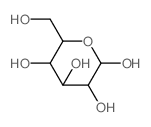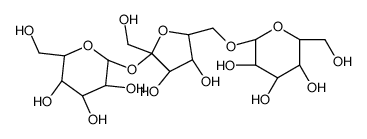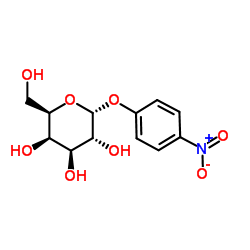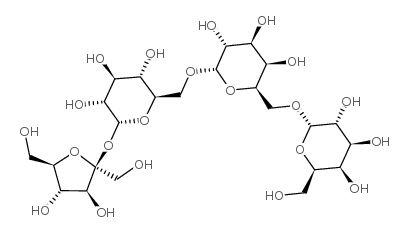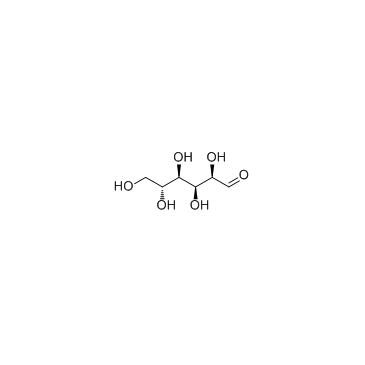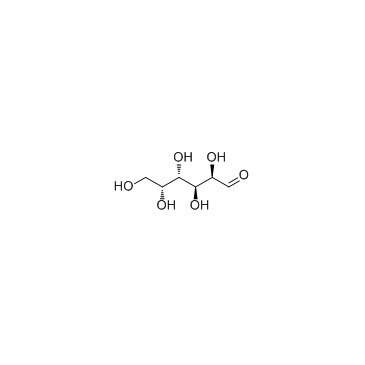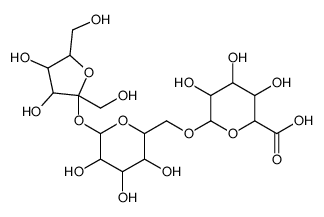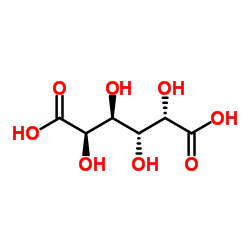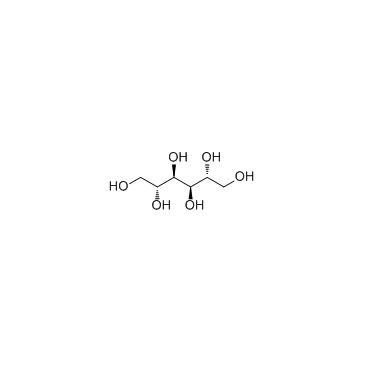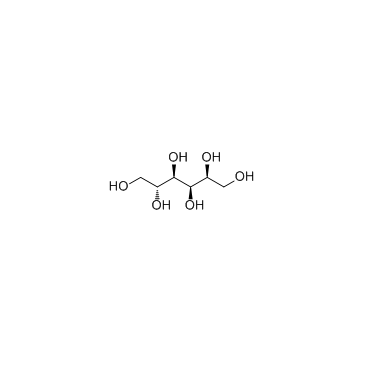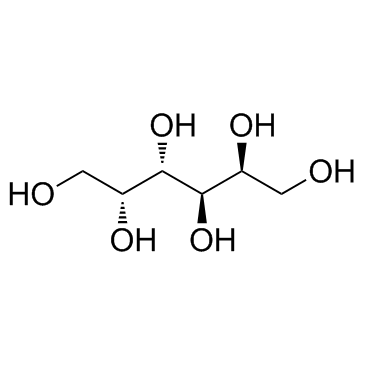512-69-6
| 中文名 | 棉子糖 |
|---|---|
| 英文名 | raffinose |
| 中文别名 | 棉籽糖 |
| 英文别名 |
(2R,3R,4S,5S,6R)-2-{[(2S,3S,4S,5R)-3,4-Dihydroxy-2,5-bis(hydroxymethyl)tetrahydro-2-furanyl]oxy}-6-({[(2S,3R,4S,5R,6R)-3,4,5-trihydroxy-6-(hydroxymethyl)tetrahydro-2H-pyran-2-yl]oxy}methyl)tetrahydro-2H-pyran-3,4,5-triol
β-D-Fructofuranosyl-α-D-galactopyranosyl-(1->6)-α-D-glucopyranoside Gossypose α-D-Glucopyranoside, β-D-fructofuranosyl O-α-D-galactopyranosyl-(1->6)- MELITRIOSE Raffinose MFCD00006630 β-D-Fructofuranosyl α-D-galactopyranosyl-(1->6)-α-D-glucopyranoside b-D-Fructofuranosyl-O-a-D-galactopyranosyl-(1®6)-a-D-glucopyranoside EINECS 208-146-9 Melitose Raffinose (8CI) D-(+)-Raffinose |
| 描述 | Raffinose (Melitose) 是一种不可消化的短链寡糖,是由半乳糖,葡萄糖和果糖组成的三糖,可在许多植物中找到。Raffinose (Melitose) 可以被 α-半乳糖苷酶 (α-GAL) 水解为 D-半乳糖和蔗糖。 |
|---|---|
| 相关类别 | |
| 靶点 |
IC50: short-chain oligosaccharide[1] |
| 参考文献 |
[1]. Raffinose |
| 密度 | 1.8±0.1 g/cm3 |
|---|---|
| 沸点 | 884.8±65.0 °C at 760 mmHg |
| 熔点 | 80ºC |
| 分子式 | C18H32O16 |
| 分子量 | 504.437 |
| 闪点 | 488.9±34.3 °C |
| 精确质量 | 504.169037 |
| PSA | 268.68000 |
| LogP | -2.50 |
| 外观性状 | 白色粉末或晶体 |
| 蒸汽压 | 0.0±0.6 mmHg at 25°C |
| 折射率 | 1.676 |
| 储存条件 | 室温,干燥,密封 |
| 稳定性 | Stable. Incompatible with strong oxidizing agents. Combustible. |
Synonym:Melitose; D-raffinose; Gossypos Section 2 - COMPOSITION, INFORMATION ON INGREDIENTS
Risk Phrases: None Listed. Section 3 - HAZARDS IDENTIFICATION EMERGENCY OVERVIEW
The toxicological properties of this material have not been fully investigated. Potential Health Effects Eye: May cause eye irritation. Skin: May cause skin irritation. Low hazard for usual industrial handling. Ingestion: May cause irritation of the digestive tract. Low hazard for usual industrial handling. The toxicological properties of this substance have not been fully investigated. Inhalation: May cause respiratory tract irritation. Low hazard for usual industrial handling. The toxicological properties of this substance have not been fully investigated. Chronic: Adverse reproductive effects have been reported in animals. Section 4 - FIRST AID MEASURES Eyes: Flush eyes with plenty of water for at least 15 minutes, occasionally lifting the upper and lower eyelids. If irritation develops, get medical aid. Skin: Flush skin with plenty of water for at least 15 minutes while removing contaminated clothing and shoes. Get medical aid if irritation develops or persists. Wash clothing before reuse. Ingestion: Never give anything by mouth to an unconscious person. Do NOT induce vomiting. If conscious and alert, rinse mouth and drink 2-4 cupfuls of milk or water. Get medical aid if irritation or symptoms occur. Inhalation: Remove from exposure and move to fresh air immediately. If not breathing, give artificial respiration. If breathing is difficult, give oxygen. Get medical aid if cough or other symptoms appear. Notes to Physician: Section 5 - FIRE FIGHTING MEASURES General Information: As in any fire, wear a self-contained breathing apparatus in pressure-demand, MSHA/NIOSH (approved or equivalent), and full protective gear. During a fire, irritating and highly toxic gases may be generated by thermal decomposition or combustion. Extinguishing Media: Use agent most appropriate to extinguish fire. Use water spray, dry chemical, carbon dioxide, or appropriate foam. Section 6 - ACCIDENTAL RELEASE MEASURES General Information: Use proper personal protective equipment as indicated in Section 8. Spills/Leaks: Vacuum or sweep up material and place into a suitable disposal container. Clean up spills immediately, observing precautions in the Protective Equipment section. Avoid generating dusty conditions. Provide ventilation. Section 7 - HANDLING and STORAGE Handling: Wash thoroughly after handling. Use with adequate ventilation. Minimize dust generation and accumulation. Avoid contact with eyes, skin, and clothing. Keep container tightly closed. Avoid ingestion and inhalation. Storage: Store in a tightly closed container. Store in a cool, dry, well-ventilated area away from incompatible substances. Section 8 - EXPOSURE CONTROLS, PERSONAL PROTECTION Engineering Controls: Good general ventilation should be sufficient to control airborne levels. Exposure Limits CAS# 512-69-6: Personal Protective Equipment Eyes: Wear appropriate protective eyeglasses or chemical safety goggles as described by OSHA's eye and face protection regulations in 29 CFR 1910.133 or European Standard EN166. Skin: Wear appropriate protective gloves to prevent skin exposure. Clothing: Wear appropriate protective clothing to prevent skin exposure. Respirators: Follow the OSHA respirator regulations found in 29 CFR 1910.134 or European Standard EN 149. Use a NIOSH/MSHA or European Standard EN 149 approved respirator if exposure limits are exceeded or if irritation or other symptoms are experienced. Section 9 - PHYSICAL AND CHEMICAL PROPERTIES Physical State: Solid Color: white Odor: Not available. pH: Not available. Vapor Pressure: Not available. Viscosity: Not available. Boiling Point: Not available. Freezing/Melting Point: 80-82C Autoignition Temperature: Not applicable. Flash Point: Not applicable. Explosion Limits, lower: Not available. Explosion Limits, upper: Not available. Decomposition Temperature: Not available. Solubility in water: Soluble in water. Specific Gravity/Density: Not available. Molecular Formula: C18H32O16.5H2O Molecular Weight: 594.2814 Section 10 - STABILITY AND REACTIVITY Chemical Stability: Stable under normal temperatures and pressures. Conditions to Avoid: Incompatible materials, dust generation, excess heat. Incompatibilities with Other Materials: Oxidizing agents. Hazardous Decomposition Products: Carbon monoxide, irritating and toxic fumes and gases, carbon dioxide. Hazardous Polymerization: Has not been reported. Section 11 - TOXICOLOGICAL INFORMATION RTECS#: CAS# 512-69-6: LZ5851200 LD50/LC50: Not available. Carcinogenicity: Raffinose Hydrate - Not listed by ACGIH, IARC, or NTP. Other: See actual entry in RTECS for complete information. Section 12 - ECOLOGICAL INFORMATION Section 13 - DISPOSAL CONSIDERATIONS Dispose of in a manner consistent with federal, state, and local regulations. Section 14 - TRANSPORT INFORMATION IATA Not regulated as a hazardous material. IMO Not regulated as a hazardous material. RID/ADR Not regulated as a hazardous material. Section 15 - REGULATORY INFORMATION European/International Regulations European Labeling in Accordance with EC Directives Hazard Symbols: Not available. Risk Phrases: Safety Phrases: S 28A After contact with skin, wash immediately with plenty of water. S 37 Wear suitable gloves. S 45 In case of accident or if you feel unwell, seek medical advice immediately (show the label where possible). WGK (Water Danger/Protection) CAS# 512-69-6: No information available. Canada CAS# 512-69-6 is listed on Canada's DSL List. CAS# 512-69-6 is not listed on Canada's Ingredient Disclosure List. US FEDERAL TSCA CAS# 512-69-6 is listed on the TSCA inventory. SECTION 16 - ADDITIONAL INFORMATION N/A |
CHEMICAL IDENTIFICATION
HEALTH HAZARD DATAACUTE TOXICITY DATA
|
| 危害码 (欧洲) | Xi |
|---|---|
| 海关编码 | 2940000000 |
| 上游产品 5 | |
|---|---|
| 下游产品 10 | |
| 海关编码 | 2940000000 |
|---|



